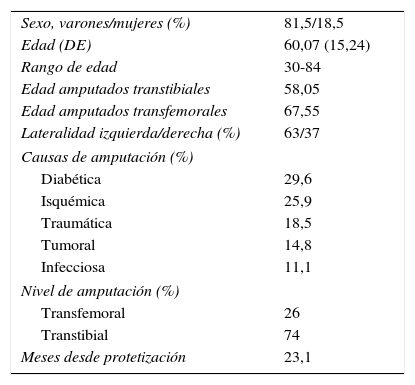El proceso de protetización del amputado de miembro inferior es un reto para el médico rehabilitador, dada la complejidad del mismo. El objetivo de este estudio es averiguar el tiempo de utilización de las prótesis en los amputados de miembro inferior de nuestro Hospital, así como conocer qué factores pueden influir en su uso.
Material y métodosHemos realizado un estudio longitudinal, observacional de los pacientes protetizados de extremidad inferior en nuestro centro en los últimos 3 años. Se han recogido datos demográficos y características de la amputación. Para conocer el tipo de deambulación con la prótesis hemos utilizado la escala de Houghton. Para valorar el nivel de independencia, las comorbilidades y la calidad de vida se utilizaron los índices de Barthel, Charlson y el cuestionario SF-12 respectivamente.
ResultadosSe obtuvo una muestra de 30 pacientes con 60 años de edad media. Veintidós amputados transtibiales y 8 transfemorales.
La rehabilitación fue satisfactoria (al menos 9 puntos en la escala Houghton) en el 73% de los pacientes. El nivel de independencia fue alto, con una media en el índice de Barthel de 87,82. Encontramos una moderada correlación negativa (−0,41) entre el índice de Charlson y las horas de uso diarias. La calidad de vida fue superior entre los pacientes con amputación transtibial.
ConclusiónEl nivel de uso de la prótesis de los pacientes de nuestro centro se puede considerar bueno, siendo la comorbilidad asociada un factor limitante en cuanto a las horas de uso.
The process of fitting a prosthesis in a lower limb amputee is a challenge for physiatrists due to the complexity of prosthetic management. The purpose of this study was to determine the actual time of usage of lower limb prostheses in our hospital and to identify the factors that can influence adherence to use.
Methods and materialsWe conducted an observational study of all patients fitted with a lower limb prosthesis in our hospital during the last 3 years. We gathered demographic data and the characteristics of the amputations. The Houghton scale was used to the classify walking ability of the amputees in our study. To evaluate the level of independence, comorbidities and quality of life, we used the Barthel Index, Charlson Comorbidity Index and the SF-12 questionnaire, respectively.
ResultsThe sample consisted of 30 patients with a mean age of 60 years. Amputations were transtibial in 22 and transfemoral in 8. The rehabilitation process was considered satisfactory (at least 9 points in the Houghton scale) in 73% of the patients. The level of independence achieved was high, with a mean of 87.82 in the Barthel Index. We found a moderate negative correlation (−0.41) between the Charlson Comorbidity Index and the daily number of hours of prosthesis use. Quality of life was higher in patients with transtibial amputations.
ConclusionsIn our centre, lower limb prostheses were used for an adequate amount of time. A limiting factor for the number of hours of use was associated comorbidity.
Artículo
Comprando el artículo el PDF del mismo podrá ser descargado
Precio 19,34 €
Comprar ahora











